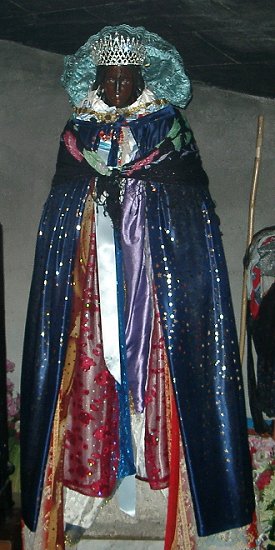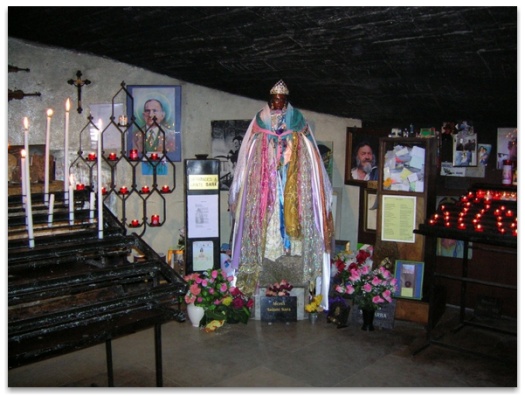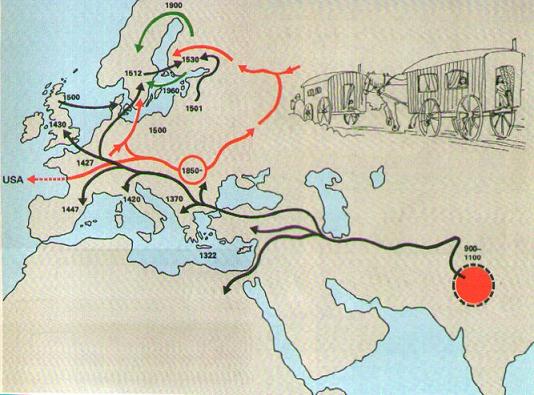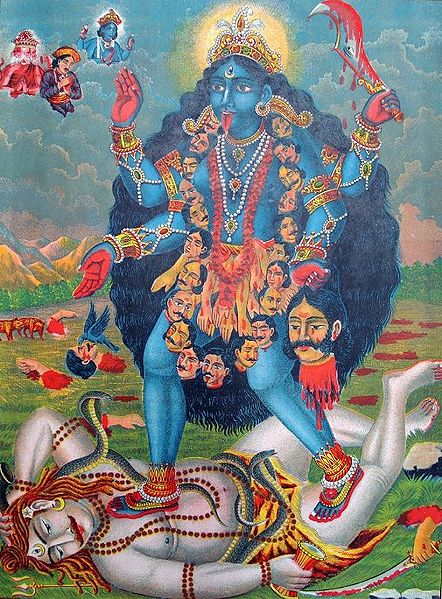It looks like you're using an Ad Blocker.
Please white-list or disable AboveTopSecret.com in your ad-blocking tool.
Thank you.
Some features of ATS will be disabled while you continue to use an ad-blocker.
6
share:

I recently came across some info on St. Sarah, a saint I’d heard of.
Saint Sarah, also known as Sara-la-Kali ("Sara the Black", Romani: Sara e Kali), is the mythic patron saint of the Roma (Gypsy) people. The center of her veneration is Saintes-Maries-de-la-Mer, a place of pilgrimage for Roma in the Camargue, in southern France. Legend identifies her as the servant of one of the Three Marys…
Source: Wikipedia

It seems she is associated with the Roma people, who are often referred to as “the Gypsies.” There is some controversy surrounding this group, but contemporary scholarship generally seems to agree that their origin was probably in India:

Now, given that the name includes the word “Kali” (or “Black” in the Roma language), I immediately thought of the Hindu Goddess Kali, who is also generally portrayed as dark-skinned and (of course) associated with India, like the Roma:

Kālī (Sanskrit: काली, IPA: [kɑːliː]; Bengali: কালী; Punjabi: ਕਾਲੀ; Tamil: காளி; Telugu: కాళికాదేవి; Kannada: ಕಾಳಿ ಮಾತೆ), also known as Kālikā (Sanskrit: कालिका, Bengali: কালিকা), is the Hindu goddess associated with empowerment, shakti. The name Kali comes from kāla, which means black, time, death, lord of death, Shiva. Kali means "the black one". Since Shiva is called Kāla—the eternal time—Kālī, his consort, also means "Time" or "Death" (as in time has come). Hence, Kāli is considered the goddess of time and change. Although sometimes presented as dark and violent, her earliest incarnation as a figure of annihilation still has some influence. Various Shakta Hindu cosmologies, as well as Shākta Tantric beliefs, worship her as the ultimate reality or Brahman. She is also revered as Bhavatārini (literally "redeemer of the universe"). Comparatively recent devotional movements largely conceive Kāli as a benevolent mother goddess.[1]
Source: Wikipedia
So the question emerges: Is St. Sarah a “Christian Kali” And are there other Hindu elements in Christianity/Catholicism?
Catholic literature on St. Sarah says she was originally a black Egyptian and associates her with the cultus of the “Three Marys.” These facts add additional layers of mystery. What, if anything, is the association of this figure with Egypt? In earlier generations, the Roma were thought by many to have been from Egypt; hence the name “[E]gypsies.” Also, her cultus and that of the “three Marys” is strongly associated with South France, always a fertile breeding ground for heterodox ideas, such as the Cathars and other “heretical” forms of medieval Christianity that were heavily Gnostic in flavor.
I’d like to open discussion on this fascinating and little-known character, which could provide a glimpse at some sort of hybrid “Christianized” Hinduism that came into Europe with the Roma and may have flourished in the doctrinally free-wheeling environment of medieval Southern France. One also wonders if there are other elements of Hinduism that have fused with Christianity via the Roma or another avenue. And we here very little about St. Sarah from official Chjristian/Catholic sources. Is this somethging they'd like to cover up? All comments welcome.
hybrid? LOL we're talking 10,000 yrs apart.
Christianity is a modern Roman reinvention/repackaging of ancient Vedas
Krisna - Kristos/Christ
ArMaghada - Armageddon
Mass - mas (ceremony)
just 3 of many other root examples
Christianity is a modern Roman reinvention/repackaging of ancient Vedas
Krisna - Kristos/Christ
ArMaghada - Armageddon
Mass - mas (ceremony)
just 3 of many other root examples
I thought a bit before I replied as I saw this was one of your threads, and of course checked it out.
Just wanted to throw into the mix that the same type of statue, and background as the photos you posted are used in Santeria www.britannica.com...
I knew I saw this somewhere before. Just throwing it out there, for a possible link.

Peace, NRE.
Star and Flag, btw I am subscribed I would love to see where this goes, btw, I have personally seen this figure thats how I knew where it came from this is the first I heard of this though.
Just wanted to throw into the mix that the same type of statue, and background as the photos you posted are used in Santeria www.britannica.com...
I knew I saw this somewhere before. Just throwing it out there, for a possible link.

Peace, NRE.
Star and Flag, btw I am subscribed I would love to see where this goes, btw, I have personally seen this figure thats how I knew where it came from this is the first I heard of this though.
edit on 10-5-2012 by NoRegretsEver because: (no reason given)
I don't think that there is any agreement on the origin of the Roma and Sinti, though there are many theories. The Roma themselves certainly do not
ascribe to a purely Indian origin but do recognise that they did pass through India. They themselves recognise strong similarities with Judiac
traditions and semitic cultures in general, and I personally feel that it is plausible that they represent an earlier diaspora of the Abrahamic
tradition of scattering to the 'four corners of the globe'.
The connection to Kali seems merely a linguistic one, Kali, meaning 'the black one', is much more likely, in my opinion, to be a representation of the tripartite goddess worshipped in pre-Christian Europe, rather than an adoption of the Hindu goddess. The Roma and Sinti are strict in their mono-theism. And there veneration of Sarah, which means Queen, is just that, they consider her their spiritual guide, or leader, her being considered by them, as the first convert of the three Mary's when they arrived in Marseilles.
The connection to Kali seems merely a linguistic one, Kali, meaning 'the black one', is much more likely, in my opinion, to be a representation of the tripartite goddess worshipped in pre-Christian Europe, rather than an adoption of the Hindu goddess. The Roma and Sinti are strict in their mono-theism. And there veneration of Sarah, which means Queen, is just that, they consider her their spiritual guide, or leader, her being considered by them, as the first convert of the three Mary's when they arrived in Marseilles.
I'm a Hindu
What St. Sarah really reminds me of, as you've mentioned ST, Kali Ma. To be honest, Hinduism and Paganism have some very similar characteristics...and as Christianity was to be honest, the downfall of Paganism and did incorporate some of it's stuff from there - there would definitely be links...but not very prominent.
We must remember that Hinduism is pretty old...and as seen from different religions, they like to "take things out that they like and mix it together with other beliefs"...hence you'll be seeing similar stuff.
Look at the Old Religions - they have major similarities...and then look at the New Religions (i.e. Christianity, Judaism and Islam) - they have loads of similarities too.
All religions have similarities...and a person would be quite ignorant to ignore them.
What St. Sarah really reminds me of, as you've mentioned ST, Kali Ma. To be honest, Hinduism and Paganism have some very similar characteristics...and as Christianity was to be honest, the downfall of Paganism and did incorporate some of it's stuff from there - there would definitely be links...but not very prominent.
We must remember that Hinduism is pretty old...and as seen from different religions, they like to "take things out that they like and mix it together with other beliefs"...hence you'll be seeing similar stuff.
Look at the Old Religions - they have major similarities...and then look at the New Religions (i.e. Christianity, Judaism and Islam) - they have loads of similarities too.
All religions have similarities...and a person would be quite ignorant to ignore them.
reply to post by BlackPoison94
We all share the same basic origins, so of course there are going to be similarities. In fact differences are really only the adaptations that ancient peoples made in order to explain the environments that were settled in, when they were settled in. Later religions, such as Christianity as a structural entity, rather than as a spirituality, are clearly meant as control mechanisms, or if we are going to be kind, as unifying forces. But at the core of all beliefs, we find the same basic prinicples because we ALL come from the same source.
We all share the same basic origins, so of course there are going to be similarities. In fact differences are really only the adaptations that ancient peoples made in order to explain the environments that were settled in, when they were settled in. Later religions, such as Christianity as a structural entity, rather than as a spirituality, are clearly meant as control mechanisms, or if we are going to be kind, as unifying forces. But at the core of all beliefs, we find the same basic prinicples because we ALL come from the same source.
originally posted by: silent thunder
I recently came across some info on St. Sarah, a saint I’d heard of.
Saint Sarah, also known as Sara-la-Kali ("Sara the Black", Romani: Sara e Kali), is the mythic patron saint of the Roma (Gypsy) people. The center of her veneration is Saintes-Maries-de-la-Mer, a place of pilgrimage for Roma in the Camargue, in southern France. Legend identifies her as the servant of one of the Three Marys…
Source: Wikipedia
It seems she is associated with the Roma people, who are often referred to as “the Gypsies.” There is some controversy surrounding this group, but contemporary scholarship generally seems to agree that their origin was probably in India:
Now, given that the name includes the word “Kali” (or “Black” in the Roma language), I immediately thought of the Hindu Goddess Kali, who is also generally portrayed as dark-skinned and (of course) associated with India, like the Roma:
Kālī (Sanskrit: काली, IPA: [kɑːliː]; Bengali: কালী; Punjabi: ਕਾਲੀ; Tamil: காளி; Telugu: కాళికాదేవి; Kannada: ಕಾಳಿ ಮಾತೆ), also known as Kālikā (Sanskrit: कालिका, Bengali: কালিকা), is the Hindu goddess associated with empowerment, shakti. The name Kali comes from kāla, which means black, time, death, lord of death, Shiva. Kali means "the black one". Since Shiva is called Kāla—the eternal time—Kālī, his consort, also means "Time" or "Death" (as in time has come). Hence, Kāli is considered the goddess of time and change. Although sometimes presented as dark and violent, her earliest incarnation as a figure of annihilation still has some influence. Various Shakta Hindu cosmologies, as well as Shākta Tantric beliefs, worship her as the ultimate reality or Brahman. She is also revered as Bhavatārini (literally "redeemer of the universe"). Comparatively recent devotional movements largely conceive Kāli as a benevolent mother goddess.[1]
Source: Wikipedia
So the question emerges: Is St. Sarah a “Christian Kali” And are there other Hindu elements in Christianity/Catholicism?
Catholic literature on St. Sarah says she was originally a black Egyptian and associates her with the cultus of the “Three Marys.” These facts add additional layers of mystery. What, if anything, is the association of this figure with Egypt? In earlier generations, the Roma were thought by many to have been from Egypt; hence the name “[E]gypsies.” Also, her cultus and that of the “three Marys” is strongly associated with South France, always a fertile breeding ground for heterodox ideas, such as the Cathars and other “heretical” forms of medieval Christianity that were heavily Gnostic in flavor.
I’d like to open discussion on this fascinating and little-known character, which could provide a glimpse at some sort of hybrid “Christianized” Hinduism that came into Europe with the Roma and may have flourished in the doctrinally free-wheeling environment of medieval Southern France. One also wonders if there are other elements of Hinduism that have fused with Christianity via the Roma or another avenue. And we here very little about St. Sarah from official Chjristian/Catholic sources. Is this somethging they'd like to cover up? All comments welcome.
Sara is not a Hindu/Christian "hybrid" goddess, really. She is Durga. She is Kali. She has been worshipped among the Romani people since the beginning, I suppose. And I would say that she isn't a Christian figure at all. Not at all. It simply looks this way. There is no real connection between christianity and Sara e Kali. Only a very, very fictional story tying her to the three Marys. When in reality she has been a part of Romani spirituality long before Christianity ever touched our lives.
originally posted by: Biliverdin
I don't think that there is any agreement on the origin of the Roma and Sinti, though there are many theories. The Roma themselves certainly do not ascribe to a purely Indian origin but do recognise that they did pass through India. They themselves recognise strong similarities with Judiac traditions and semitic cultures in general, and I personally feel that it is plausible that they represent an earlier diaspora of the Abrahamic tradition of scattering to the 'four corners of the globe'.
The connection to Kali seems merely a linguistic one, Kali, meaning 'the black one', is much more likely, in my opinion, to be a representation of the tripartite goddess worshipped in pre-Christian Europe, rather than an adoption of the Hindu goddess. The Roma and Sinti are strict in their mono-theism. And there veneration of Sarah, which means Queen, is just that, they consider her their spiritual guide, or leader, her being considered by them, as the first convert of the three Mary's when they arrived in Marseilles.
No, we very much acknowledged fact that our ancestral homeland is India.
There is great mystery behind the environment of Southern France, dealing with the Three Mary’s, The Virgin Mary, the Black Madonna’s, and the
well-known mystery of Rennes Le Château.
I’ve basically solved this mystery and am contemplating a book on the matter.
The only thing is the story is so esoteric it would be difficult to elucidate all the information unless people are brought up on some of the mystery. That has been done somewhat, or at least attempted, by the people behind the Rennes Le Château mystery, the Book, Holy Blood Holy Grail, and the bestselling novel, The Davinci Code in this modern era. However, the story goes back centuries through the mystery of the story of Jesus and the twelve disciples, John the Baptist, and Mary Magdalene, all the way back to the primordial Fall of Man Allegory….Reverting forward into the future to the medieval middle ages of the Knights Templar, their relationship with the Sufis of that era, and connecting to the grail mystery, and the Ark of the Covenant of later times.
The modern lore behind these mysterious events and the Chateau mystery are educational tools to make some of the public familiar with the alternative interpretations to the Jesus mythos.
My job would be to consolidate these materials and create a story that makes sense and explains these primary mysteries:
What the Ark of the Covenant is and what the Grail is, literally, and their connection to the religious mythos and the apocalypse scenario.
Jesus and his 12 disciples…John the Baptist….Mary Magdalene… Mary the Virgin, who they were or who they really reflected from heaven.
And their relationship with the Fall of Man allegory and mythos of the apocalypse
The true esoteric meaning of Christianity, in that it is really a story of not the sacrifice of Jesus alone, but the sacrifice of all of humankind.
The revealing of the science behind the hidden but coming to light mystery of the lore of the esoteric rumblings that have been going on in Southern France.
Who is the Priory of Sion? What secret are they really hiding?
I will only say here briefly that the secret does revolve around the Mary Magdalene figure as many of the researchers suggest. However, it extends further to another major figure the researchers rarely mention and that is Mary the Virgin. They never comment on the relationship of the two.
The reason researchers are usually insufficient in understanding the essence of all these connected mysteries is that most of them become professional writers no longer seekers after truth, which is the reason the truth is never told fully. They do not know it because they have become too interested in publishing a commercially successful book, not seeking the truth.
Any book I write I would seriously consider not selling it commercially.
I’ve basically solved this mystery and am contemplating a book on the matter.
The only thing is the story is so esoteric it would be difficult to elucidate all the information unless people are brought up on some of the mystery. That has been done somewhat, or at least attempted, by the people behind the Rennes Le Château mystery, the Book, Holy Blood Holy Grail, and the bestselling novel, The Davinci Code in this modern era. However, the story goes back centuries through the mystery of the story of Jesus and the twelve disciples, John the Baptist, and Mary Magdalene, all the way back to the primordial Fall of Man Allegory….Reverting forward into the future to the medieval middle ages of the Knights Templar, their relationship with the Sufis of that era, and connecting to the grail mystery, and the Ark of the Covenant of later times.
The modern lore behind these mysterious events and the Chateau mystery are educational tools to make some of the public familiar with the alternative interpretations to the Jesus mythos.
My job would be to consolidate these materials and create a story that makes sense and explains these primary mysteries:
What the Ark of the Covenant is and what the Grail is, literally, and their connection to the religious mythos and the apocalypse scenario.
Jesus and his 12 disciples…John the Baptist….Mary Magdalene… Mary the Virgin, who they were or who they really reflected from heaven.
And their relationship with the Fall of Man allegory and mythos of the apocalypse
The true esoteric meaning of Christianity, in that it is really a story of not the sacrifice of Jesus alone, but the sacrifice of all of humankind.
The revealing of the science behind the hidden but coming to light mystery of the lore of the esoteric rumblings that have been going on in Southern France.
Who is the Priory of Sion? What secret are they really hiding?
I will only say here briefly that the secret does revolve around the Mary Magdalene figure as many of the researchers suggest. However, it extends further to another major figure the researchers rarely mention and that is Mary the Virgin. They never comment on the relationship of the two.
The reason researchers are usually insufficient in understanding the essence of all these connected mysteries is that most of them become professional writers no longer seekers after truth, which is the reason the truth is never told fully. They do not know it because they have become too interested in publishing a commercially successful book, not seeking the truth.
Any book I write I would seriously consider not selling it commercially.
new topics
-
Judge rules president-elect Donald Trump must be sentenced in 'hush money' trial
US Political Madness: 2 hours ago -
Farmers wife
Music: 3 hours ago -
NJ Drones tied to Tesla explosion at Trump Las vegas
General Conspiracies: 4 hours ago -
New Jersey-Teachers Can Now Be Certified Without Passing Basic Reading Writing Math Testing
Education and Media: 7 hours ago -
Matthew Livelsberger said he was being followed by FBI
Political Conspiracies: 10 hours ago
top topics
-
Matthew Livelsberger said he was being followed by FBI
Political Conspiracies: 10 hours ago, 16 flags -
Here we again... CHINA having mass outbreak of something
Diseases and Pandemics: 14 hours ago, 8 flags -
The 119th Congress has Officially Opened for Business
Mainstream News: 14 hours ago, 7 flags -
New Jersey-Teachers Can Now Be Certified Without Passing Basic Reading Writing Math Testing
Education and Media: 7 hours ago, 7 flags -
Paranoid Liberals Believe U.S. Service Members are More Dangerous than Illegal Aliens.
Social Issues and Civil Unrest: 13 hours ago, 6 flags -
How the Sikhs Deal with Muslim Grooming Gangs – Tommy Robinson
Social Issues and Civil Unrest: 12 hours ago, 6 flags -
NJ Drones tied to Tesla explosion at Trump Las vegas
General Conspiracies: 4 hours ago, 3 flags -
Farmers wife
Music: 3 hours ago, 1 flags -
Judge rules president-elect Donald Trump must be sentenced in 'hush money' trial
US Political Madness: 2 hours ago, 0 flags
active topics
-
Candidate TRUMP Now Has Crazy Judge JUAN MERCHAN After Him - The Stormy Daniels Hush-Money Case.
Political Conspiracies • 2173 • : WeMustCare -
Judge rules president-elect Donald Trump must be sentenced in 'hush money' trial
US Political Madness • 2 • : Dalamax -
Tesla Cybertruck Explodes in Front of Trump Hotel in Las Vegas
Mainstream News • 198 • : Mantiss2021 -
Matthew Livelsberger said he was being followed by FBI
Political Conspiracies • 63 • : BeyondKnowledge3 -
Paranoid Liberals Believe U.S. Service Members are More Dangerous than Illegal Aliens.
Social Issues and Civil Unrest • 30 • : hangedman13 -
Musk calls on King Charles III to dissolve Parliament over Oldham sex grooming gangs
Mainstream News • 88 • : WeMustCare -
-@TH3WH17ERABB17- -Q- ---TIME TO SHOW THE WORLD--- -Part- --44--
Dissecting Disinformation • 3923 • : RelSciHistItSufi -
Watts home paranormal activity
Paranormal Studies • 6 • : TowmasterLG -
Congress Says the FBI is Covering Up Vital Info on the Jan 5th 2021 D.C. Pipe Bombs at RNC-DNC.
Political Conspiracies • 28 • : GotterDameron23 -
New Jersey-Teachers Can Now Be Certified Without Passing Basic Reading Writing Math Testing
Education and Media • 9 • : rickymouse
6
